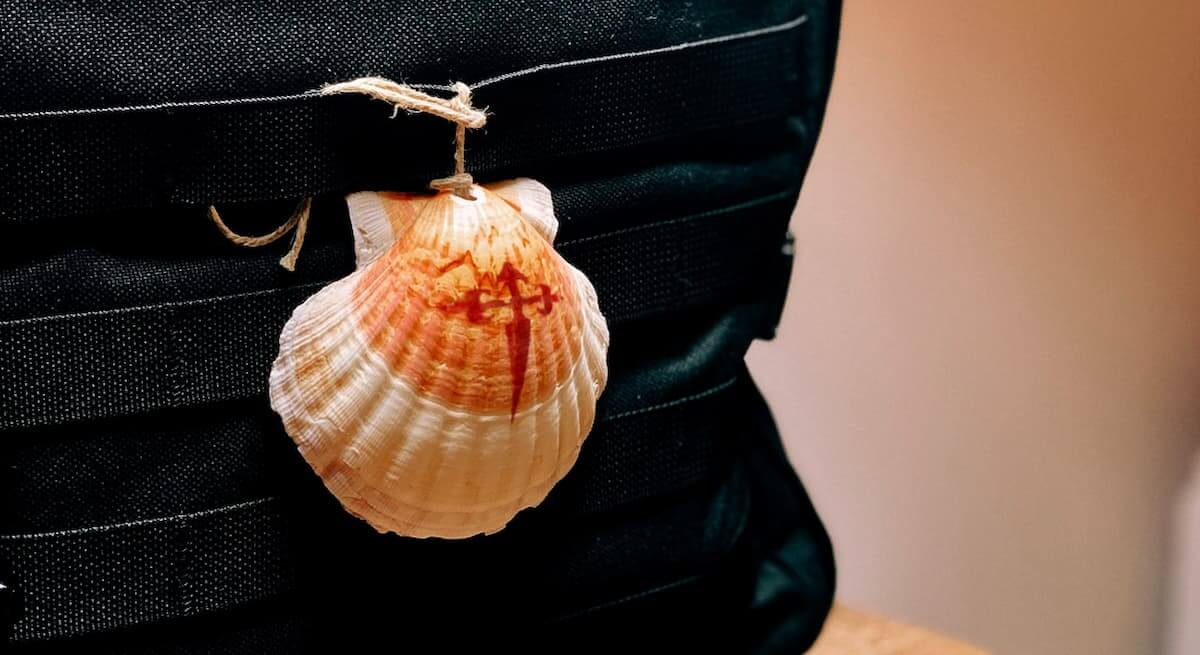- Index
- What is the origin of the Cruz de Santiago?
- What is the significance of the Cruz de Santiago?
- Where can we find the Cruz de Santiago?
- The Cross as a symbol: live the Way
There are several representative symbols of the Camino de Santiago: the yellow arrows, the scallop shell, the pumpkin, the wooden staff… If you dare to walk the Camino or simply visit the Galician capital, you will easily find them everywhere.
Of all of them, one of the most important is still the Saint James Cross, due to its significance, its presence and its enormous historical value.
That is why we want to tell you about the origin of this cross, as well as the reasons why it is shaped like a sword and has such a characteristic red colour.
What is the origin of the Cruz de Santiago?
Some believe that the origin of the St James Cross dates back to the battle of Clavijo in 844. In this battle between Moors and Christians, the latter were apparently victorious thanks to the appearance of the Apostle Saint James, on the back of a white horse and carrying a flag on which this cross was depicted.
Another disputed origin of the Cross of St. James goes much further back in time, to the time of the Christian Crusades. At that time, it seems that Christian knights carried crosses with a sharpened end so that they could nail them to the ground as they passed by and leave a record of their presence, as well as perform their daily prayers.
Be that as it may, the red Cross of Saint James became the emblem of the Military Order of Santiago from the 12th century,whose members wore it stamped on the standard they carried as well as on their white cloak, while they carried out their most important task: protecting and sheltering the pilgrims who walked the Way of St. James to the tomb of the Apostle.
Today, the Cruz de Santiago is also the symbol of the representatives of the Chapter of the Cathedral of Santiago.
What is the significance of the Cruz de Santiago?
The Cross of St. James, although it is a Latin cross, is actually in the shape of a sword. This can be seen in its short hilt and its straight, pointed end, similar to that of a sword or dagger.
On the arms of the cross we can distinguish the fleur-de-lis at both ends: this symbol represents honour and purity, characteristics attributed to the Apostle St. James, but also to the Holy Trinity due to its three petals. Finally, it is also associated with obedience and submission to divine commandments.
Shaped like a sword, this cross symbolises the defence of the Christian faith, as well as being the very weapon with which the Apostle James was beheaded. From this decapitation also derives its red colour, called “gules” in heraldry, which represents the blood shed by the Apostle as a Christian martyr.
Where can we find the Cruz de Santiago?
From its historic origins to the present day, the Cross of St. James can be seen on a wide variety of items and objects, from official coats of arms to souvenirs of all kinds.
The popular ”tarta de Santiago” is one of them. Made with almonds, this Galician cake is characterised by being decorated with the Cross of St James in the centre, surrounded by the icing sugar with which the surface is sprinkled.
It goes without saying that the coat of arms of the city of Santiago de Compostela features this cross, as well as the tomb of the Apostle St. James in white marble. The same is true of the emblem of their local football team, in which the Cross of St James takes centre stage, as it does in the football team of Celta de Vigo, which since 1928 has added the cross to its emblem to mark its Galician identity.
Even in pieces of art such as the famous painting of Las Meninas by Velázquez, the Cross of Saint James can be seen represented in the image of the painter himself. The detail of the cross on his breastplate, however, seems to have been added years later, on the occasion of his appointment as a knight of the Order of Santiago and after Velázquez received the corresponding habit.
The Cross as a symbol: live the Way
Nowadays, the Cross of St. James appears on various signs along the Camino, depicted on all kinds of souvenirs and painted on the characteristic scallop shell. It is, in fact, one of the favourite symbols that pilgrims choose to get tattooed on their arrival in Compostela, after living the experience of the Camino de Santiago.
If you are also thinking of doing the Camino de Santiago and want more information, remember that, in addition to telling you this kind of curiosities, we can help you to plan it in detail: contact us and encourage you to undertake this adventure.
Plan your adventure!
We give you all the information without any commitment!

